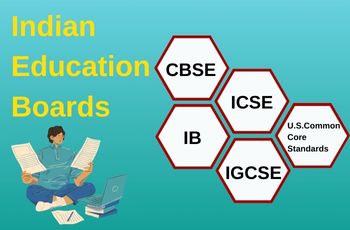As students are revising for the upcoming CBSE Class 12 board exams, having the knowledge of a detailed CBSE syllabus for Class 12 would definitely help. In this article, we shall provide you with the CBSE Class 12 syllabus for Biology. This will help students preparing for NEET as well, the medical entrance exam conducted by CBSE. The syllabus for NEET is same as that of CBSE syllabus of Class 11 and 12. Read on to find out the detailed CBSE Class 12 syllabus for Biology.
Name of the Units and their weightage in CBSE 12 Biology Board Exam
|
1 |
Reproduction |
14 |
|
2 |
Genetics and evolution |
18 |
|
3 |
Biology and Human Welfare |
14 |
|
4 |
Biotechnology and its applications |
10 |
|
5 |
Ecology and environment |
Details of topics and sub-topics to be covered in each unit
Unit VI: Reproduction
Chapter-1: Reproduction in Organisms
Reproduction, a characteristic feature of all organisms for continuation of species; modes of reproduction - asexual and sexual reproduction; asexual reproduction - binary fission, sporulation, budding, gemmule formation, fragmentation; vegetative propagation in plants.
Chapter-2: Sexual Reproduction in Flowering Plants
Flower structure; development of male and female gametophytes; pollination-types, agencies and examples; outbreeding devices; pollen-pistil interaction; double fertilization; post fertilization events-development of endosperm and embryo, development of seed and formation of fruit; Special modes-apomixis, parthenocarpy, polyembryony; Significance of seed dispersal and fruit formation.
Chapter-3: Human Reproduction
Male and female reproductive systems; Microscopic anatomy of testis and ovary; gametogenesis-spermatogenesis & oogenesis; menstrual cycle; fertilization, embryo development upto blastocyst formation, implantation; pregnancy and placenta formation (elementary idea); parturition (elementary idea); lactation (Elementary idea).
Chapter-4: Reproductive Health
Need for reproductive health and prevention of sexually transmitted diseases (STDs); birth control – need and methods, contraception and medical termination of pregnancy (MTP); amniocentesis; infertility and assisted reproductive technologies - IVF, ZIFT, GIFT (elementary idea for general awareness).
Unit VII: Genetics and Evolution
Chapter-5: Principles of Inheritance and Variation
Heredity and Variation: Mendelian inheritance; deviations from mendelism - incomplete dominance, co-dominance, multiple alleles and inheritance of blood groups, pleiotropy; elementary idea of polygenic inheritance; chromosome theory of inheritance; chromosomes and genes; Sex determination - in humans, birds, honey bee; linkage and crossing over; sex linked inheritance - haemophilia, colour blindness; mendelian disorder in humans - thalassemia; chromosomal disorders in humans; Down's syndrome, Turner's and Klinefelter's syndromes.
Chapter-6: Molecular Basis of Inheritance
Search for genetic material and DNA as genetic material; Structure of DNA and RNA; DNA packaging; DNA replication; Central dogma; transcription, genetic code, translation; gene expression and regulation - lac operon; genome and human and rice ganeome project; DNA fingerprinting.
Chapter-7: Evolution
Origin of life; biological evolution and evidences for biological evolution (paleontological, comparative anatomy, embryology and molecular evidence); Darwin's contribution, modern synthetic theory of evolution; mechanism of evolution - variation (mutation and recombination) and natural selection with examples, types of natural selection; Gene flow and genetic drift; Hardy - Weinberg's principle; adaptive Radiation; human evolution.
Unit VIII: Biology and Human Welfare
Chapter-8: Human Health and Diseases
Pathogens; parasites causing human diseases (malaria, dengue, chickengunia, filariasis, ascariasis, typhoid, pneumonia, common cold, amoebiasis, ring worm) and their control; Basic concepts of immunology - vaccines; cancer, HIV and AIDs; Adolescene, drug and alcohol abuse.
Chapter-9: Strategies for Enhancement in Food Production
Improvement in food production; Plant breeding, tissue culture, single cell protein, Biofortification, Apiculature and Animal husbandry.
Chapter-10: Microbes in Human Welfare
In household food processing, industrial production, sewage treatment, energy generation and microbes as biocontrol agents and biofertilizers. Antibiotics; production and judicious use.
Unit IX: Biotechnology and Its Applications
Chapter-11: Biotechnology - Principles and Processes
Genetic engineering (Recombinant DNA technology).
Chapter-12: Biotechnology and its Application
Application of biotechnology in health and agriculture: Human insulin and vaccine production, stem cell technology, gene therapy; genetically modified organisms - Bt crops; transgenic Animals; biosafety issues, bio piracy and patents.
Unit X: Ecology and Environment
Chapter-13: Organisms and Populations
Organisms and environment: Habitat and niche, population and ecological adaptations; population interactions-mutualism, competition, predation, parasitism; population attributes - growth, birth rate and death rate, age distribution.
Chapter-14: Ecosystem
Ecosystems: Patterns, components; productivity and decomposition; energy flow; pyramids of number, biomass, energy; nutrient cycles (carbon and phosphorous); ecological succession; ecological services - carbon fixation, pollination, seed dispersal, oxygen release (in brief).
Chapter-15: Biodiversity and its Conservation
Concept of biodiversity; patterns of biodiversity; importance of biodiversity; loss of biodiversity; biodiversity conservation; hotspots, endangered organisms, extinction, Red Data Book, biosphere reserves, national parks, sanctuaries and Ramsar sites.
Chapter-16: Environmental Issues
Air pollution and its control; water pollution and its control; agrochemicals and their effects; solid waste management; radioactive waste management; greenhouse effect and climate change; ozone layer depletion; deforestation; any one case study as success story addressing environmental issue(s).
Prescribed books
- Biology, Class-XII, Published by NCERT
- Other related books and manuals brought out by NCERT (consider multimedia also)
TIPS AND TRICKS:
Notes and Diagrams
Preparing notes at the time of teaching would become very useful in a conceptually dependent subject like Biology. Not only does it help in the process of remembering the terms while writing, it also helps in the student’s last minute preparation strategies. This subject is heavy on theory so to facilitate the student’s consistent interest, it is useful to draw diagrams and to base the preparation structure around them. Repeated practice of drawing diagrams can help drawing neatly. Diagrams and labeling are also asked in entrance exams like AIPMT and AIIMS. A question might have a huge theoretical answer but this can be reduced to a simple explanative answer by drawing the necessary diagrams (case in point – DNA structure, cell biology etc.).
Chapterwise
Chapters like Genetics and Biotechnology need to be understood well to make them easy. They go hand in hand and hence should be prepared together. The chapters that carry 14 marks each (reproduction, ecology and human welfare) are broad which contain a lot of detailed sub topics and hence should be prepared first.
Cramming?
Do not try to cram the subject as it will make you miss out on important points for exam. Instead, prepare on a consistent basis of at least 2 to 3 weeks prior to the exam. Participate in the class as some of the concepts can be brought out clearly on clarifications from the teachers. It is also a healthy practice to compare notes and ask doubts among friends as ideas when shared lead to more ideas.
Productive Breaks
If you know your concentration is going to wander of course it is better to take breaks in between topics. During these breaks try to recollect what was studied and/or try practicing diagrams and be resourcefully productive.
Flashcards
One strong advice from alumni would be to create “flashcards” for remembering definitions and labeling parts in diagrams. It is better to take notes in class in points/bullets as the order of answers fetches you more marks. It is important to revise the course at least 3 times before an examination. For lengthy biological names use mnemonics. Break up the names in a way that will aid in remembering them.
Past year papers
It is a good practice to sit and write the past year exam and sample papers with a timer set to simulate the exam day. This will help in creating awareness of time management and will help relieve stress caused due to availability of less time in answering theoretical long answer type questions.



















Comments